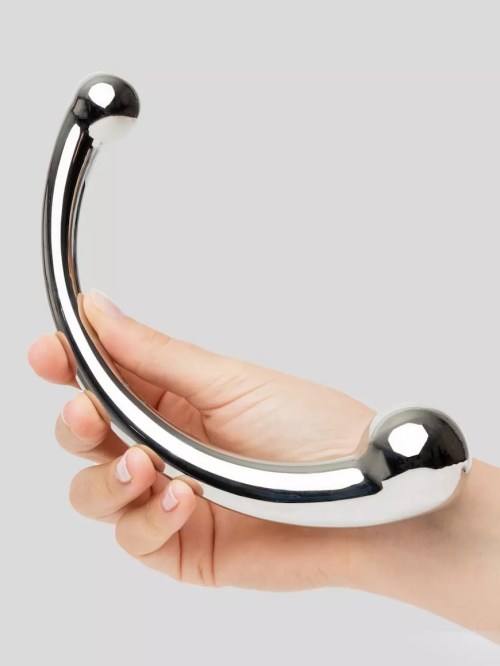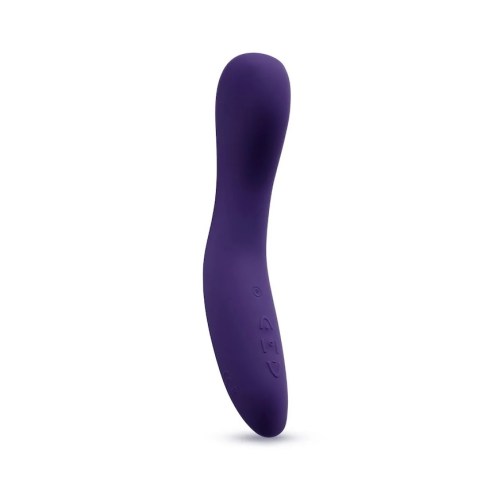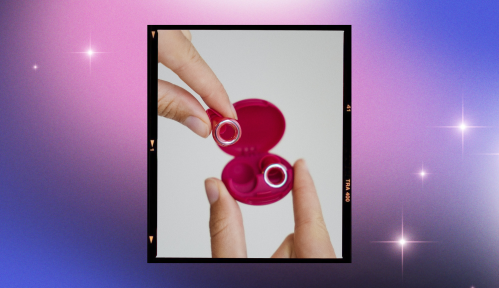Our editors independently select these products. Making a purchase through our links may earn Well+Good a commission
What Is a Cervical Orgasm? Sex Experts Share What It Feels Like and How To Have One
Cervical orgasm is possible thanks to these cervix stimulation tips. Here's what cervical orgasm feels like and how to have one yourself.

There’s no denying that the clitoris, the G-spot (or G-zone), and the anus have fantastic PR teams that have helped spread the good word on historically overlooked female pleasure zones. But there’s one potential hotspot that hasn’t gotten as much public (nor private!) attention as it deserves: the cervix, and with it, the cervical orgasm.
Experts in This Article
certified sex educator, certified sexuality coach, and founder of b-Vibe
certified sex therapist
sexologist and host of the podcast Sex With Dr. Jess
licensed clinical social worker and sexologist
If you’ve ever taken a human anatomy class or gotten an IUD (or intrauterine device), you’re probably aware that the cervix is part of the reproductive system. Essentially the cul-de-sac at the end of the vaginal canal, the cervix is a ring of connective tissue and muscle that keeps bacteria and debris out of the uterus, says certified sex therapist and somatic psychologist Holly Richmond, PhD, LMFT, associate director of Modern Sex Therapy Institutes. While its main job is to protect the womb, the cervix acts like a gate that allows menstrual blood and discharge to leave the body, and sperm to enter, she explains.
“Many [people] report that cervical orgasms feel like pleasure and heat that start in the abdomen and extend deep into the body.” —Holly Richmond, PhD, LMFT, somatic psychologist
A little known fact about the cervix, however, is that its stimulation can result in some feel-good pleasure—and potentially even orgasm, says sexologist Jess O’Reilly, PhD, host of the Sex With Dr. Jess podcast. Vaginal penetration that is deep enough can put pressure on the cervix, which can lead to cervical orgasm, she explains. Generally described as eliciting pleasure that is more “full-body” than clitoral orgasms, cervical orgasms straight-up feel different from many other orgasms (in a very, very good way).
Whether it leads to orgasm or not, though, adding cervical play into your sexual repertoire can help you get to know your body better. Ahead, everything you need to know about the erogenous zone that deserves more regard than it’s gotten this far, including exactly how to explore cervical pleasure whether you’re solo or with a partner (or two), plus what a cervical orgasm feels like and how to actually have one.
What is a cervical orgasm?
A cervical orgasm is pretty much exactly what it sounds like: an orgasm that results from stimulating the cervix, says Dr. O’Reilly. Or more specifically, stimulating the portion of the cervix that can be reached via stimulation at the way back of the vaginal canal. (To be clear: The rest of the cervix can not be accessed outside of childbirth, IUD removal and insertion, and surgery.)
The accessible portion of the cervix, Dr. O’Reilly explains, is made from a nerve-rich connective tissue that can respond favorably to different types of stimulation. In some instances, individuals prefer a tapping or vibrating stimulation, while in others, people prefer pressure, she says.
When compared to other types of orgasms, “a cervical orgasm is significantly different from a G-spot, vaginal, or clitoral orgasm,” says Dr. Richmond, in regard to both the sensation of the orgasm, as well as the type of stimulation required to get there.
The G-spot orgasm is an orgasm induced from stimulation of the G-spot, which is “a spongy tissue located on the anterior wall of the vagina, about 2.5 inches in and up toward the belly button,” says Dr. Richmond. G-spot orgasms are often described as a slower build orgasm, and are often accompanied by the feeling of fluid release (squirting), or the intense feeling that one is about to go to the bathroom, she says.
Meanwhile, clitoral orgasm is the name for the intense but localized orgasm achieved from stimulation of the external bud of the clitoris. “The clitoris is actually shaped like a wishbone,” explains Dr. Richmond. (So in addition to the nub-like portion you can see, there are also nerve-dense “legs” that extend back into the vaginal wall, she says.)
Vaginal orgasm is the term for any orgasm elicited through stimulation of the vaginal canal. “Sometimes called a penetrative orgasm, vaginal orgasms are usually caused when the legs of the clitoris are stimulated repeatedly during vaginal penetration,” explains Dr. Richmond.
It may be a fun exercise to parse out the differences in sensation and required stimulation among the different types of orgasms. “But it is often difficult for the person having the orgasm to differentiate between whether they are having a cervical, vaginal, clitoral, or G-spot orgasm,” says Dr. O’Reilly. “The area is small and there are so many nerve endings in the region,” she says. That’s why, rather than trying to pinpoint the source, she recommends focusing instead on the sensation and overall pleasure.
Is a cervical orgasm always possible?
A cervical orgasm is not always possible—and that’s okay! “There is great variation in the human experience of pleasure,” says Dr. O’Reilly. So, just as not everyone who has nipples enjoys having their breasts or chest-buds stimulated, not everyone with a cervix will enjoy the sensation of having their cervix stimulated, she says. And in that case, it is highly unlikely that you will be able to tolerate its stimulation long enough for orgasm to occur, she explains.
Even people who enjoy cervical stimulation some of the time may not enjoy it all the time. The position of your cervix can change throughout the month, says Dr. Richmond. Generally, the cervix shifts up toward the uterus during ovulation to support conception and then tilts down towards the vaginal canal afterward. Some people may enjoy cervical stimulation when the cervix is higher up in the body and not open (like at the tail end of ovulation), she says, but find it painful other times of the month.
“Some people also only enjoy cervical stimulation if they are sufficiently aroused,” says Dr. O’Reilly. A wide range of things from relationship satisfaction and pre-play duration, to hydration levels and recent nutrient intake can all impact the body’s physiological experience of arousal. As such, an individual’s capacity to experience pleasure from cervical stimulation can depend on a number of lifestyle factors on any given day, too.
Can a cervical orgasm occur during penetrative sex?
Yes, cervical orgasms refer to any orgasm that occurs in response to pressure against the cervix through the vagina, says Dr. O’Reilly. So vaginal penetration—be it with a penis, dildo, or other body-safe sex toy—is actually required for cervical stimulation, she says.
Given that the cervix is anywhere from three to six inches deep inside the vaginal canal, “most often, people and their partners are not able to reach their cervix with just their fingers,” says Dr. Richmond. (Though, individuals with particularly long and dexterous digits may be able to.)
Anatomically speaking, it’s not possible for the cervix to be stimulated indirectly through anal penetration, in the way that the G-spot may be. But while anal penetration will not lead to cervical stimulation, it can add more pleasure into the mix if that’s your cup of tea.
What does a cervical orgasm feel like?
Cervical orgasms are described as being “full-body” and often as “more intense” than other kinds of orgasms, says Dr. Richmond. “Many [people] report that cervical orgasms feel like pleasure and heat that start in the abdomen and extend deep into the body,” she says.
Given that the only way to access the cervix is through deep vaginal penetration, both cervical stimulation and cervical orgasm are often associated with a feel-good sensation of fullness, too. Indeed, some people who enjoy cervical stimulation report that the sensation is accompanied by the feeling of being stuffed or stretched.
Dr. O’Reilly notes that due to the location of the cervix (in the back of the vaginal canal), it is common for cervical stimulation to be accompanied by stimulation of other nerve-dense regions in that canal, too, such as the G-zone and internal clitoral legs. Combining stimulation of multiple hotspots at once—such as the cervix and the vaginal canal—can lead to a blended orgasm, she says. This unique, supercharged orgasm can feel as good as “jumping into an Alpine lake under the stars on a warm, autumn night,” Stuart Nugent, brand manager at luxury sex-toy company LELO, previously told Well+Good.
How many inches does it take to hit the cervix?
The cervix is located anywhere from three to six inches deep inside the vaginal canal, says sexologist Shamyra Howard, LCSW, an AASECT-certified sex therapist with sex toy retailer Lovehoney. The specific location of yours (or your partner’s) lies somewhere in that spectrum and depends on an individual’s unique anatomy, as well as where they are in their menstrual cycle, how aroused they are, and more.
Rather than using length as an indicator of whether you’ve reached the cervix, Howard suggests going by feel. Given that the cervix is located at the very end of the vaginal canal, you’ll know that you’ve reached the cervix when it feels like you’re being penetrated deep inside the vaginal canal and do not feel like you can physically be penetrated any further, she explains.
Is cervical stimulation safe?
“Yes, cervical simulation is safe,” says Dr. Richmond. As a general rule, so long as the stimulation feels good—and not painful—it is perfectly safe for you to proceed, and you should do so in the name of pleasure.
The cervix will open oh-so-slightly during ovulation and again during menstruation to release ovulatory fluid and blood, respectively. But so long as the toy or body part you are using to stimulate the cervix during this time is clean, it is still safe to stimulate the cervix. This opening, says Dr. Richmond, will be so infinitesimally small that there is no risk that you will end up widening this hole, penetrate the cervix, or end up stimulating the uterus.
“Cervical stimulation is also safe for people with IUDs,” says Dr. Richmond. “The IUD sits in the uterus, not on the cervix,” she explains. Stimulation of the cervix will not impact the uterus or any contraceptive device within it in any way, shape, or form.
Does stimulating the cervix hurt?
For some people, stimulating the cervix might hurt or be uncomfortable. That’s because cervical stimulation is not going to be everybody’s jam, just as nipple and anal stimulation aren’t going to be—and that’s okay!
“Pleasure from cervical orgasm is not a universal experience, and it is normal to find it uncomfortable,” says Dr. O’Reilly. Some people always find cervical stimulation to be annoying, uncomfortable, or downright painful, she says. Meanwhile, others only describe it as such during certain times throughout their menstrual cycle but really enjoy it at other points, she says.
Dr. Richmond notes that it’s also possible to find certain types of cervical stimulation uncomfortable but to enjoy other types. “Some people, for example, report that it feels like they are getting punched in the cervix when their partner penetrates them deeply or intensely during vaginal intercourse but then end up enjoying less intense, more gentle cervical stimulation with a sex toy,” she says.
When exploring cervical stimulation, it’s important to remember the point of sex-ploring is pleasure. “If something feels uncomfortable, pull back,” says Dr. O’Reilly. “Trust your body, and know that you’re not missing out if you don’t enjoy one specific pathway to pleasure.”
How to have a cervical orgasm during solo or partnered play
1. Get fully aroused before you start
No matter what type of orgasm you have, it’s always a marathon, not a sprint. To that end, any sexual experience you have will be exponentially better when you’re turned on, so give yourself the time for external stimulation and whatever other forms of pre-orgasm activity you enjoy.
For cervical play, this is an important first step, says Howard. That’s because the sensitive tissue gets pumped full of blood when you’re aroused, which makes it more responsive to touch. “During arousal, the body also starts producing endorphins and oxytocin that can have a calming and palliative effect,” says Dr. O’Reilly, which ultimately makes cervical stimulation feel better.
Here, your move is to lean on whatever sex acts you already know turn you on. Depending on whether you’re playing alone or with another, that may include cunnilingus or using an air section toy, anilingus or inserting a butt plug, or stimulating any other erogenous zone.
2. Focus on cautious exploration
Once you feel you’ve reached full arousal, it’s time to add in vaginal penetration, says certified sexologist Alicia Sinclair, CEO of sex-toy brand Le Wand.
Whether playing solo or with a partner, Dr. O’Reilly recommends starting with a finger, or a dildo and lubricant in the instance that the fingers on hand (ha) are not long enough. It is easier to experiment with depth and pressure this way than it would be if you attempted exploration via penile penetration, she says. Plus, these penetrative devices also allow you to stop and enjoy other pleasure zones (like the G-spot) on your way to cervical stimulation, in the event that more shallow penetration makes you moan and groan.
When you eventually do get deep, Sinclair suggests continuing to experiment with light stimulation to see how it feels. You might “try tapping or gently pulsing deep into the vaginal canal to stimulate the cervix,” and see if you enjoy that, she says.
3. Use a long wand or vibrator
Cervical stimulation generally requires deep—like the deepest—penetration. So yes, you may need a larger (or at least longer) sex toy than what you typically opt for.
Howard says that most stainless steel or glass wands and dildos, such as the The Lovehoney Sensual Glass Double Ended G-spot Dildo ($37) or nJoy Pure Wand ($150) are sound choices for cervical stimulation, as the hardness of the material makes it optimal for applying pressure.
If you generally enjoy internal vibration, Dr. O’Reilly suggests a slightly C-shaped vibrator, like the We-Vibe Rave ($140) instead. “You can rotate and rock the toy when it’s deep inside of you, using the asymmetrical handle to apply vibration and pressure to the cervix,” she says.
Best sex toys for cervical stimulation

LoveHoney Sensual Glass Double-Ended G-Spot Dildo — $37.00

njoy Pure Wand Stainless Steel Dildo — $150.00

We-Vibe Rave — $140.00
4. Get on top during partnered sex
Grab your cowboy hat, because if you’re planning to explore cervical stimulation with a partner, rider-on-top is the best position. “Being on top allows for deeper penetration while allowing you to control the depth, speed, angle, and rhythm of cervical contact,” says Dr. O’Reilly. She suggests leaning your torso down toward your partner while you ride, as this will increase pressure along the front of your body and may support cervical stimulation.
5. Don’t fret if you don’t love cervical stimulation
If you’re enjoying the quest for cervical bliss, but you still don’t think you’re really hitting it, consider trying again at a later date, suggests Dr. O’Reilly. Given that, again, the position of the cervix changes along with your hormones each month, cervical stimulation might feel better at some points in your cycle than others, she says.
But ultimately, you might just find out that riding toward a cervical orgasm just… isn’t your thing. “Don’t be upset if this type of stimulation doesn’t get you off,” Sinclair says. “Vulva-owners are incredibly lucky in the sense that we have a wide variety of pleasure zones. While a cervical orgasm might work for one person, it’s totally fine if clitoral orgasms are more your jam.”
Everyone’s different in this respect, so the trick is to keep checking back and getting to know what makes you tick—and if an orgasm is the reward, all the better. But if not? Hey, sexual self-knowledge is a pretty damn compelling reward, too.
Sign up for the Well+Good SHOP Newsletter
Get exclusive deals on wellness, beauty, fitness, and food products that have been hand-picked by our editors.
Got it, you've been added to our email list.









